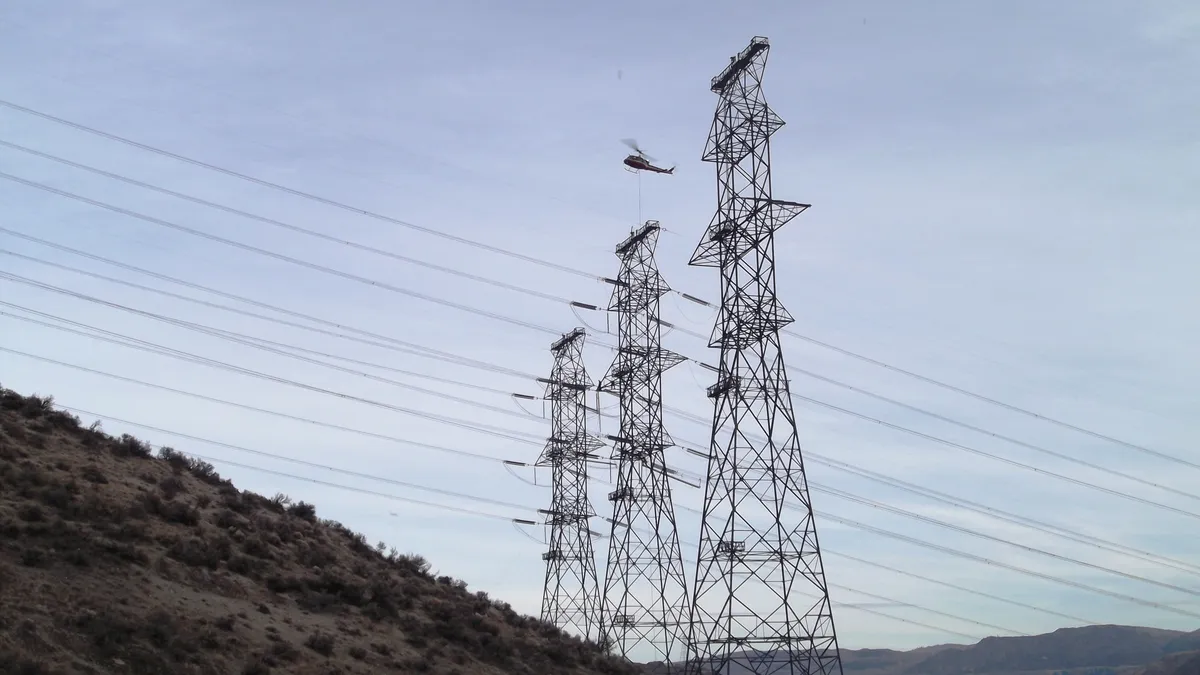Utilities and other transmission developers brought 55 miles of high-voltage transmission lines into service in 2023, according to a report released Tuesday by Grid Strategies.
Through May this year, one project — the 125-mile, 500-kV Delaney-to-Colorado line between Arizona and California — has started operating, Grid Strategies said, citing the Federal Energy Regulatory Commission.
High-voltage transmission construction — 345-kV or greater — has fallen since the early 2010s when about 1,700 miles was added each year on average, according to the report. High-voltage additions fell to 925 miles on average from 2015 to 2019, and 350 miles a year from 2020 to 2023, Grid Strategies said.
Despite the decline in building high-voltage power lines, utility spending on transmission infrastructure increased to more than $25 billion last year, up from about $20 billion in 2013, according to the consulting firm.
More than 90% of the spending is on lower voltage, reliability-driven transmission projects that are often built outside of regional transmission planning processes without consideration for broader benefits that transmission can provide, according to the report.
“Multi-value projects would maximize benefits to ratepayers while also helping achieve state policy goals or unlocking other economic benefits such as lower cost generation,” Grid Strategies said.
The Edison Electric Institute, a trade group representing investor-owned utilities, expects its members will spend about $30 billion a year on transmission over three years starting this year, Grid Strategies said in the report, which was drafted with support from Americans for a Clean Energy Grid.
A transmission buildout in the 2010s shows that comprehensive transmission planning can facilitate new power lines that increase net-benefits to ratepayers compared to “reactive, siloed, ‘local’ planning processes that focus almost solely on ‘just-in-time’ piecemeal additions,” Grid Strategies said.
The Midcontinent Independent System Operator’s Long Range Transmission Planning Tranche 1 Portfolio approved in July 2022 is an example of effective transmission planning, according to the report.
The $10.3 billion portfolio includes 18 transmission projects, totaling more than 2,000 miles, that MISO expects will produce $23.2 billion to $52.2 billion in net benefits over the next 20 to 40 years, Grid Strategies said.
“We know how to build large scale transmission because we built a lot a decade ago,” Rob Gramlich, Grid Strategies president and one of the report’s authors, said in a statement. “Policy changes to address planning, permitting, and paying would get transmission back on track.”
Some transmission projects, such as TransWest Express and SunZia, are advancing in the West, the report noted. Also, projects being developed by LS Power, NV Energy, PacifiCorp and others are ready to go or moving ahead, according to the report.
“A coordinated, proactive and multi-value planning process, such as what is being undertaken through the WestTEC process, could streamline development and provide significant value across the West,” Grid Strategies said.
Action at the Federal Energy Regulatory Commission, the U.S. Department of Energy and in Congress is supporting transmission development, but more private investment is needed, according to the consulting firm.
“Both policymakers and regulators must capitalize on FERC’s issuance of Order No. 1920 to ensure the momentum brought about by federal action truly changes the incentives for transmission investment and helps spur a massive investment in the construction of new high-voltage transmission lines to ensure a reliable and affordable transition to a cleaner grid,” Grid Strategies said.
Meanwhile, the Senate Energy and Natural Resources Committee is set to vote on a permitting reform bill on Wednesday. Among other things, the bill would bolster FERC’s authority to approve transmission lines and require interregional transmission planning.














